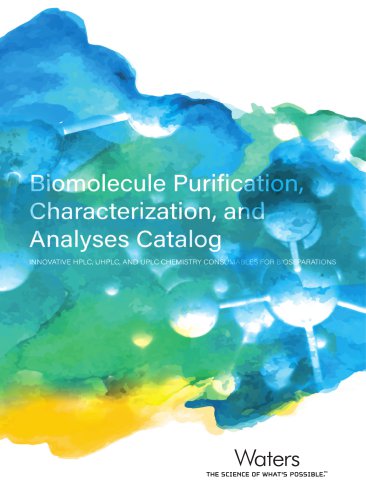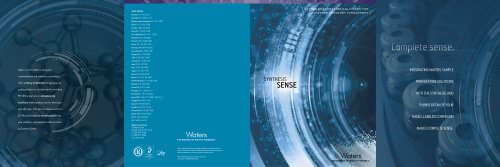 Website:
Waters Ges.m.b.H
Website:
Waters Ges.m.b.H
Catalog excerpts

I. INT RODUC T ION This Care and Use Manual contains information pertaining to the use of the following Protein-Pak™ SEC Columns: a. Steel Column Installation b. Glass Column Installation c. Solvent Requirements d. Buffers e. Protein Denaturants f. Equilibration g. Column Purge Volumes Protein-Pak 60 7.8 mm (i.d.) x 30 cm, Steel (P/N WAT085250) Recommended for use with biopolymers such as peptides, polypeptides, steroids and small proteins. The pore size distribution provides excellent separation in the following molecular weight ranges: Native Globular 1000–20,000 and Random Coil 600–8000. Shipped in 100% methanol. Protein-Pak 125 7.8 mm (i.d.) x 30 cm, Steel (P/N WAT084601) a. Sample Preparation and Filtration b. Precautions c. Cleaning and Regeneration d. Storage Considerations a. Service and Applications Information b. Column Efficiency c. Test Conditions Especially suited for separation of biopolymers such as proteins and enzymes in the following molecular weight ranges: Native Globular 2000–80,000 and Random Coil 1000–30,000. Shipped in 100% methanol. Protein-Pak 300 SW 7.5 mm (i.d.) x 30 cm, Steel (P/N WAT080013) Protein-Pak 200 SW 8.0 mm (i.d.) x 30 cm, Glass (P/N WAT011786) Protein-Pak 300 SW 8.0 mm (i.d.) x 30 cm, Glass (P/N WAT011787) The columns of choice for use with larger biological active molecules in the molecular weight range of Native Globular 10,000–400,000 and Random Coil 2000–150,000. Shipped in 0.05% sodium azide in wate
Open the catalog to page 1
b. Glass Column Installation a. Steel Column Installation Waters Protein-Pak 200 or 300 SW glass columns can be connected to any HPLC or medium-pressure system remembering not to exceed 300 psi backpressure with the installed glass SEC columns. The following parts can be used to adapt these columns to any of our standard Waters systems: Remove the end plugs from your column with a 5/18” wrench and save them for storage when the column is removed from the system. The column outlet is indicated by an arrow on the label (showing the direction solvent should flow). Tighten the fittings...
Open the catalog to page 2
a. Sample Preparation and Filtration A necessary step to successful use of your new column is the initial solvation (or wetting) of the packing. Purge the column with 5–10 column volumes of the stronger eluting component of the mobile phase alone before a final purge with the actual mobile phase. Equilibration between the mobile phase and packing is established when a stable baseline can be produced. If your result is unsatisfactory repeat the equilibration process. Use HPLC grade solvents, filtered to remove microparticulate matter above the 0.45 μm. This reduces the problem of plugged...
Open the catalog to page 3
Avoid precipitation. DO NOT inject sample directly into the mobile phase whenever possible. Dissolve (or dilute) samples in an appropriate volume of the mobile phase first. If other solvents must be used, be sure that no precipitation occurs when they are injected into the mobile phase. DO NOT store column in water alone for more than three days, this practice will promote microbial contamination. Store this series of columns in a 0.05% sodium azide in water solution. DO NOT allow buffers or other potentially harmful materials to remain in the system overnight when not being used. Flush and...
Open the catalog to page 4
b. Column Efficiency Waters measures the efficiency of the Protein-Pak 60 and 125 columns by using the 5 sigma method. Plate count as an expression of efficiency, is determined by measuring the peak width at 4.4% of the peak height method. N= Column Efficiency Ve= Elution time (min) W 1/2= Half width value of sample peak (min) taken at half height (1/2 h) Figure 2. Half Height Method N = Column efficiency Vr = Elution volume (mL) or distance from INJET (mm) W 1/2= Volume at 4.4% of peak height (mL) or peak width at 4.4% (mm) Figure 3. 5 Sigma Method
Open the catalog to page 5
c. Test Conditions Columns are thoroughly testing in our quality control laboratories for adherence to our specifications. Since slight variations in your results will occur depending on the equipment used, test your sample makeup and equipment settings and condition, perform the test sample run given here for your new column and record the results (retention time and the settings used) before attempting the first analysis. Use these results for comparison throughout the life of your column. Detectors should run at 254 nm or 280 nm [UV]; otherwise, use instrument settings that produce an...
Open the catalog to page 6All Waters Ges.m.b.H catalogs and technical brochures
-
Preparative OBD Columns Brochure
12 Pages
-
ACQUITY UPLC M-Class
3 Pages
-
Viridis®
6 Pages
-
Trefoil™
7 Pages
-
Torus™
7 Pages
-
Enzymate BEH Pepsin Columns
5 Pages
-
XBridge™
12 Pages
-
2432
2 Pages
-
ACQUITY UPLC I-Class PLUS
6 Pages
-
ACQUITY UPLC H-Class PLUS
6 Pages
-
ProteinWorks
6 Pages
-
HPLC Column Performance
30 Pages
-
PoraPak Rxn Brochure
8 Pages
-
Food Testing Solutions Brochure
14 Pages































